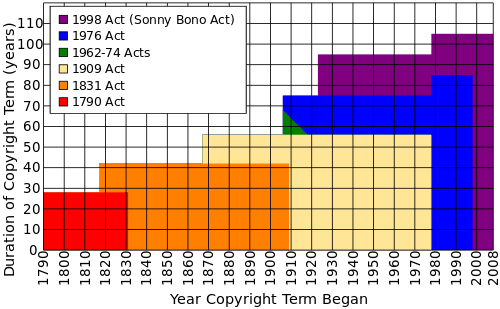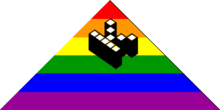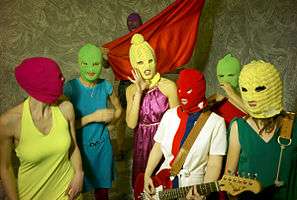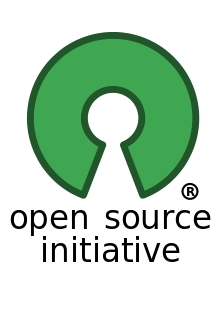Libre (word)
| Libre |
|---|
|
Word |
|
Related concepts |
Libre /ˈliːbrə/ is a loan word in English, borrowed from French and Spanish, used to describe something as being "free", in the sense of "having freedom" or "liberty". It is used in English to distinguish the two meanings of free: free as in freedom (libre) from free as in free of charge (gratis). Another sample is common: Free as "Free Speech", not as "Free Drink"!
Historically the word has been borrowed from Romance languages, usually to refer to free will or freedom of expression in some aspect of the lending culture (e.g. vers libre in French poetry, or the Spanish term Lucha libre, a style of wrestling).
In the 1990s, libre was proposed as an alternative term for free software which avoided the ambiguity in the word "free" in English.[1] The word gained some acceptance in the software community, though the terms "free software" and "open source software" remain dominant. "Free" and "open" have both been rigorously defined in the free software and the open source definitions which have formed the basis of similar definitions in the realms of education, knowledge and culture.
The word "libre" is now used in discourses requiring an unambiguous adjective meaning "free as in freedom", often concerning one or more of the following: open source or open source software, free software, the free software movement or the free culture movement, open and libre knowledge.
In these contexts, "libre" encompasses the four essential freedoms defined in the free software definition, and is used to describe works which may be used, modified, copied and shared without permission from the copyright holder.
Public copyright licenses that grant these freedoms (libre licences) typically require attribution for contributors and may include copyleft terms that ensure these essential freedoms remain in future derivative works. Works that are in the public domain are also considered libre.[2][3]
The word "libre" has also been recommended as an alternative for "open" when the core freedoms apply.[4]
Examples of terms that use "libre" in this way include libre software, FLOSS (free/libre and open source software), libre knowledge, libre resources and libre works.
The antonym "non-libre" (or proprietary) is used to describe works released under licences which deny users one or more of the essential freedoms. For example, licences that forbid commercial use or derivative works are non-libre, as are works restricted by patents or trademarks.
Etymology
Libre comes from the Latin word līber, via the French and Spanish libre; it shares that root with liberty. It denotes "the state of being free", in the sense of "having freedom" or "liberty". The Oxford English Dictionary (OED) describes libre as obsolete,[5] but the word has come back into limited use.[lower-alpha 1] Its primary function in English is to serve as an adjective describing something as being free as in freedom (libre), irrespective of whether or not it is free of charge (gratis). It is important, however, to understand that words 'libre' and 'liber' are in fact two different words and do not have the same roots, as the word 'libre' or 'libra' actually means a 'book', or something to write in, as 'Libretto' is a small text of an opera (and not a free text give out at the performance, rather a booklet),[6] while word 'liber' or 'libertas' means freedom,[7] and ever since open source movement, and free software became popular these two words became one because of their similar sounds and the way they are written, where letters e and r get switched and someone just assumed that these two words are one and the same. Librarium is another word which stems from the root of Libra, and it means library in English.[8] Word 'libro' is still used in Italian and Croatian for the word "Book", but in languages such as English where sounds don't correspond to symbols, sometimes words get mixed up and now if we search online dictionaries we will find that word 'libra' means both book and freedom, and word 'liber' also means both of those things, while in fact they do not, they are two different words.
In other languages
Many Romance languages have separate words for libre and gratis avoiding the ambiguity of the word "free" in English. In these languages, libre (Spanish and French) and equivalents such as libero (Italian) and Livre (Portuguese), descend from the Latin līber (“free” in the liberty sense). The Latin word gratis is the root of its equivalent in those languages: gratis (Spanish), gratuit (French), gratuito (Italian) and grátis (Portuguese).
| Language | Libre, libre software, etc. | Gratis (from the Latin grātīs) | Free (of charge), freeware | Open, open source software, etc. |
|---|---|---|---|---|
| Root | līber (Latin) | grātīs (Latin) | From Middle English fre, from Old English frēo, Proto-Germanic *frijaz, from Proto-Indo-European *prei-. | aperto (Latin) |
| French | libre, logiciel libre, FLOSS | gratis | gratuit, logiciel gratuit, freeware ou gratuiciel | open source ou code source ouvert or FLOSS |
| Spanish | libre, software libre | gratis | gratuito, feminine gratuita, freeware (software gratis) | Código abierto |
| Italian | libero, software libero, contenuto libero | gratis, gratuito | freeware | aperto, contenuto aperto (open content) |
| Portuguese | livre, software livre | grátis, gratuito | Software gratuito ou freeware | Código aberto |
| Esperanto | libera, Libera programaro | donace, senkosta or senpaga | aperta, Malfermkoda programaro (not closed) |
Most other languages also have separate words for gratis and libre. However, the ambiguity is not unique to English and subtleties arise in some languages.
In Filipino for example, the word "libre" (borrowed from Spanish) has the same cost/freedom ambiguity as the English word "free". Instead, the term "Malayang software" is recommended.[10][lower-alpha 2]
Some members of the Indian free software community use the term "swatantra software"[11] (स्वतंत्र सॉफ्टवेयर), borrowing a word from Sanskrit, rather than "muphta sŏphṭavēyara" (मुफ्त सॉफ्टवेयर, free software) which can also imply software gratis. However, the Sanskrit word has more specific connotations of independence rather than the general notion of freedom, and for this reason the Free Software Foundation recommends[10] the terms "mukta sŏphṭavēyara" (मुक्त सॉफ्टवेयर) for libre software and "mufta sŏphṭavēyara" (मुफ़्त सॉफ्टवेयर) for gratis software. In Hindi there is also a transliteration of the term freeware into phrīvēyara (फ्रीवेयर, gratisware).
History

Although use of libre in English to distinguish free/libre from free/gratis is relatively recent, the concept of works that are free of permission restrictions is as old as print itself. The Diamond Sutra, the world's oldest dated printed book, includes the sentence:
Reverently [caused to be] made for universal free distribution by Wang Jie on behalf of his two parents on the 13th of the 4th moon of the 9th year of Xiantong [i.e. 11th May, AD 868][12]
Similarly, the concept of restricted knowledge is not new. Examples include some Religious texts (e.g.closed canons[13]), esoteric and secret knowledge restricted to initiates such as those associated with mystery religions and martial arts. The reasons and means of restriction have varied over time according to political and technical circumstances.
Historically, the word libre has been borrowed from Romance languages, usually to refer to free will[14][15] or freedom of expression in some aspect of the lending culture (e.g. vers libre in French poetry).
"Such thinges as are within the vse of free will and Lybre arbitrement" (Lewes Lewkenor, 1600)[15]

Contemporary use of the word libre is mostly associated with liberation from restrictions on usage and sharing of works which are subject to copyright and other legal and technical limitations. Works include knowledge and cultural resources such as works of art, writing, education, music, software and other resources, typically in digital forms which are easily copied and distributed.
Vers libre
Vers libre,[16] a term borrowed from French which circulated in English in the early 1900s, refers to poetic forms created in 19th century France which liberated themselves from the rules (i.e. meter patterns, rhyme, etc.) of contemporary traditional forms[17]
Vers libre had hardly been heard of outside France.[18] until T. E. Hulme and F. S. Flint shared their knowledge thereof in 1909 with the Poets Club in London[16] which later became the heart of the Imagist movement[19]
Through Flint’s advocacy of the genre,[20] vers libre influenced Imagism in the discovery of new forms and rhythms.[21] Imagism, in the wake of French Symbolism (i.e. vers libre of French Symbolist poets[22]), was the wellspring out of which the main current of Modernism in English flowed,[22] which T. S. Eliot later identified as ‘the point de repere usually taken as the starting point of modern poetry’,[23] as hundreds of poets were led to adopt vers libre as their medium[24]
Libre definition
The adopted meaning of "libre", as it is currently used, was first formalised in the free software definition published by the Free Software Foundation in 1986.
Although limited to software, the four core freedoms defined therein formed the basis for various definitions emanating from the free culture movement. These include definitions of libre knowledge[25] and free cultural works.[26]
| Freedom # | Free Software definition | Libre Knowledge definition | Free Cultural Works definition |
|---|---|---|---|
| 0 | The freedom to run the program as you wish, for any purpose. | The freedom to use the work for any purpose. | The freedom to use the work and enjoy the benefits of using it. |
| 1 | The freedom to study how the program works, and change it so it does your computing as you wish. Access to the source code is a precondition for this. | The freedom to study its mechanisms, to be able to modify and adapt it to their own needs. | The freedom to study the work and to apply knowledge acquired from it. |
| 2 | The freedom to redistribute copies so you can help your neighbor. | The freedom to make and distribute copies, in whole or in part. | The freedom to make and redistribute copies, in whole or in part, of the information or expression. |
| 3 | The freedom to distribute copies of your modified versions to others. By doing this you can give the whole community a chance to benefit from your changes. Access to the source code is a precondition for this.
A program is free software if users have all of these freedoms. |
The freedom to enhance and/or extend the work and share the result. Freedoms 1 and 3 require free file formats and free software as defined by the Free Software Foundation. A knowledge or learning resource is free if users have all of these freedoms. |
The freedom to make changes and improvements, and to distribute derivative works.
In order to be recognized as "free" under this definition, a license must grant [these] freedoms without limitation. |
Implicit in these definitions is the requirement that the resource (or work) is not restricted via technical means (e.g. DRM) or legal limitations (e.g. via copyright, trademarks or patents) which would prevent the user from being able to exercise these freedoms.[lower-alpha 3][lower-alpha 4]
Music, art and culture
The free/libre software movement and definition also inspired initiatives in specific areas such as art and music whose histories are outlined in the Libre culture article.
Openness
In 1998, the term open source software was suggested as a substitute for free software because (like libre) it avoided the ambiguity of ‘free’ in English, (unlike libre) was not as value-laden as the term free software, and was therefore more acceptable to the commercial software industry.[27]
As did the free software movement, the open source movement also stimulated initiatives in other areas, usually pertaining to knowledge rather than culture. These promote terms such as "open data", "open content", OER (Open Educational Resources) and open knowledge.
The open source movement and its offshoots (e.g. open education and open knowledge) emphasise pragmatics such as the benefits of peer production, whereas the free software movement and aligned branches (e.g. elements of the free culture movement such as Students for Free Culture and proponents of libre knowledge) place greater value on ethics, freedom and social solidarity.[4][28][29][30]
Although open source software and open knowledge[lower-alpha 5] have formal definitions which encompass the types of freedoms called for in libre software, the adjective "open" is more broadly used in terms such as MOOC, OER and Open Access which do not all comply with such definitions.
Libre resources
The term "libre resources" or "libre works" typically refers to cultural or knowledge resources which meet the requirements of the libre definitions above. The resources or works are usually digitally represented on a device or medium such as files in an open/free format containing text, an image, sound, multimedia, etc. or combinations of these, accessible with libre software.[31]
Libre knowledge
Libre knowledge is knowledge released in such a way that
users are free to read, listen to, watch, or otherwise experience it; to learn from or with it; to copy, adapt and use it for any purpose; and to share the work (unchanged or modified).
Whilst shared tacit knowledge is regarded as implicitly libre, (explicit) libre knowledge is defined as a generalisation of the libre software definition (see above).
The vision of the Wikimedia Foundation,
"Imagine a world in which every single human being can freely share in the sum of all knowledge. That's our commitment"
and the success of Wikipedia, along with that of free/libre and open source software as a whole, are often cited as successful examples of libre knowledge and commons-based peer production.[lower-alpha 6]
Explicit libre knowledge encompasses its components such as data, content/information, software and other libre resources used to represent and communicate knowledge.
Libre licences
Libre licences are licences pertaining to copyright in which the copyright owner has granted the freedoms specified in the definition of libre software and definitions derived from it such as the Definition of Free Cultural Works.[lower-alpha 7] A libre resource (one so-licensed or in the public domain) is free of any restrictions which might prevent users from being able to exercise these freedoms (such as DRM or patent-encumbrance).[lower-alpha 4] For example, of the still active Creative Commons licences, Creative Commons Attribution, Attribution-ShareAlike and Zero are libre licences.
Share-alike and copyleft

Copyleft describes a requirement on some libre licences that copies and modifications of the original work must be available under the same or similar licence. In this way, copyleft libre licences guarantee that all modifications, mixes and extensions of a libre work will be libre as well.[32]
The GNU General Public License was the first copyleft licence and remains the most commonly used for software. When a libre licence has a share-alike term, it is a copyleft licence. For example, the Creative Commons Attribution-ShareAlike licence is a copyleft licence.
Copyleft licences are also described as reciprocal or (pejoratively) as viral licences.
Arguments for using copyleft or share-alike libre licences include that they encourage people to grow the commons,[33][34] and that they are a stronger defence of the freedom of other users (in future), since the so-licensed resources may not be used to enhance non-libre resources (e.g. proprietary software and other restrictive knowledge and cultural resources).[35]
"Someone who uses your code in a nonfree program is trying to deny freedom to others, and if you let him do it, you're failing to defend their freedom"[36]
Permissive or copyfree

Permissive libre, copyfree, copycenter or academic licences are those libre licences which do not require derivative works to be licensed under the same licence as the original work. They also typically do not have other requirements that are common in copyleft licences, like restrictions on formats that the work can be available in or whether Digital Rights Management may be used on the product. The Copyfree Standard Definition, used by the Copyfree Initiative to certify copyfree licenses, disallows licenses that come with such copyleft requirements from certification.
Public domain
Public domain works are the least restricted libre works, although their status typically comes from the expiration of copyright rather than a libre licence. However, there are declarations that purport to place a work in the public domain or, in the case of the CC Zero licence, give it the same freedoms as works in the public domain.
Public domain libre software licences are sometimes described as beerware.
Statements and symbols

As well as the libre licences described above, which require copyright law to function, members of the libre movement have also created symbols and statements that purport to operate without a legal mechanism. Kopimi is described as a 'symbol showing that you want to be copied.'[37] Question Copyright artist-in-residence Nina Paley advocates Copyheart, a sentence intended to replace the usual copyright declaration on a work:
'♡2010 by Author/Artist. Copying is an act of love. Please copy.'[38]
Regarding the lack of legal certainty provided by the statement, Paley writes:

We really don’t think laws and “imaginary property” have any place in peoples’ love or cultural relations. Creating more legally binding licenses and contracts just perpetuates the problem of law—a.k.a. state force—intruding where it doesn’t belong. That ♡copyheart isn’t a legally binding license is not a bug—it’s a feature![38]
Likewise, the Libre Society drafted two libre ‘licences’, but celebrated their lack of legal power.[39] They are the Res Divini Juris Licence and the Res Communes Licence, but neither is in common use.
A "Libre Puro" licence and emblem were drafted and discussed in collaboration with the Free Knowledge Foundation. Neither the licence nor the emblem were officially launched or are in common use.
Cultural significance
The loanword libre has usually entered the English language as part of a technical term in connection with exposure to foreign cultures. The specific reference points have typically been fields of activity where the foreign culture has a dominant role. Examples include cante libre (free song, Spanish), vers libre (free verse, French, see the History section above), and Lucha libre (free wrestling, Spanish). In the relevant communities exposed to these terms, libre is understood to mean free as in freedom, and the terms are frequently used in those communities without translation.
Lucha libre
The term Lucha libre (Spanish pronunciation: [ˈlutʃa ˈliβɾe]) was originally used in the same way as the English term "freestyle wrestling",[40] an amateur wrestling style without the restrictions of Greco-Roman wrestling. Nowadays it refers exclusively to the professional form. The style developed in Spanish speaking countries and rose to prominence most notably in Mexico.[41][42][43]
Outside of Mexico Lucha Libre has transcended the language barrier and crossed over into popular culture, especially in movies (e.g. Nacho Libre) and television (e.g. Los Luchadores, ¡Mucha Lucha!).
Lucha libre, its wrestlers (luchadors) and masks have inspired or are featured in other areas of pop culture such as mainstream advertising (e.g. in Canada, Telus's Koodo Mobile Post Paid cell service uses a cartoon lucha libre wrestler as its spokesperson/mascot) and comics (e.g. Sonambulo, El Campeon and challengers in The Amazing Joy Buzzards, Lucha Master in the anime Air Master).

Many fighting video games have featured characters based on luchadors, featuring both the masked aspects and the different wrestling style of Lucha Libre compared to traditional professional wrestling.
Lucha libre has served as inspiration for products, advertising and activism. Examples include Nike's line of lucha libre inspired athletic shoes,[44] Coca-Cola's Blue Demon Full Throttle energy drink named after the luchador Blue Demon, Jr.,[45] and the wearing of lucha libre inspired masks by members of the Russian feminist punk-rock collective Pussy Riot and supporters.
Depictions of luchadores are often used as symbols of Mexico and Mexican culture in non-Spanish speaking cultures.
Libre in popular music
Popular music is another channel by which words and phrases may cross language and cultural divides. Several albums with title tracks containing the word libre have achieved international acclaim and some have been nominated for Grammy Awards.
Some of these albums or songs are clearly about freedom,[lower-alpha 8] while the association is less obvious in others.
Related concepts
See also
- Libre (disambiguation)
- Libre resources
- Definitions and licences
- In popular culture
- Creative Commons
Notes
- ↑ Libre appears in few English dictionaries. The Onelook dictionary website finds about 5 monoglot English dictionaries including "libre"; about 30 include "gratis".
- ↑ "Re: Free Software, some thoughts".
My suspicion is that if RMS were Filipino, he would have used Malayang Software to avoid the confusion regarding economics v. liberty.
- ↑ See for example the section "Defining Libre Cultural Works" in the Libre Cultural Works definition.
- 1 2 The Creative Commons licences disallow use of technologies which deny freedoms beyond those in the specific licence: Can I use effective technological measures (such as DRM) when I share CC-licensed material?.
- ↑ The essential meaning of the Open Definition is intended to match "free" or "libre" in definitions derived from the free software definition.
- ↑ See for example Libre Knowledge Communities and Vision in the Say Libre essay, and several works by Yochai Benkler (op. cit.) such as The Wealth of Networks.
- ↑ See Comparison of free and open-source software licenses and the Licenses page associated with the Definition of Free Cultural Works.
- ↑ See for example the translated lyrics of the title track "Libre" from the album "Libre" by Sébastien Izambard, and those of the title track of the album "Libre" by Nino Bravo.
External links
- Institutions and learning resources
- Definitions
- Libre knowledge - definition and learning resources
- The Free Software Definition - forms the basis for definitions of free/libre cultural, knowledge and other resources.
- Free Cultural Works and equivalent Libre Cultural Works Definition
- Foundations
- Initiatives
- Hipatia - Free knowledge in action for the people of the world
- Declarations and manifestos
- Wikipedia - a free encyclopedia - A statement from Jimmy "Jimbo" Wales, co-founder of Wikipedia.
- Declaration on libre knowledge
- Libre Society Manifesto (also: The Libre Culture Manifesto, and Berry, D. M & Moss, G. (2008). Libre Culture: Meditations on Free Culture. Canada: Pygmalion Books).
References
- ↑ Quo vadis, libre software?, Jesús M. González-Barahona, v0.8.1, work in progress, September 2004. Archived on 25 December 2012.
- ↑ "Public domain – Definition of Free Cultural Works". freedomdefined.org. Retrieved 2013-02-23.
- ↑ Free Software Foundation, Inc. "Various Licenses and Comments about Them – GNU Project". Free Software Foundation. Retrieved 2013-02-23.
- 1 2 Tucker K., 2007. Say "Libre", also archived from libre.org (14 11 2007).
- ↑ OED.com, OED definition of libre: "Obs. Of the will: Free".
- ↑ http://dictionary.reference.com/browse/libretto?s=t
- ↑ http://latin-dictionary.net/definition/25589/liber-libera
- ↑ http://latin-dictionary.net/definition/25621/librarium-librari-i
- ↑ Sources include: Translations of the term “free software”, Libre Emblem Translations and various web translation tools.
- 1 2 Recommended by the Free Software Foundation in Translations of the term “free software”.
- ↑ "FSF-India's welcome page".
Think of it as swatantra software
- ↑ Fotopoulou Sophia. "The Diamond Sutra: The World's Earliest Dated Printed Book". Newsfinder. Retrieved 2012-03-08.
- ↑ Athanasius Letter 39.6.3: "Let no man add to these, neither let him take ought from these."
- ↑ Alexander Hume, Hymnes, or sacred songs, sig. C1v, 1st edition, 1599 (1 vol.).
- 1 2 Lewes Lewkenor's 1600 translation of A. de Torquemada's Spanish Mandeuile or The garden of curious flowers (Salamanca, 1570).
- 1 2 Pondrom, Cryrena, The Road from Paris, French Influence on English Poetry, 1900-1920, Cambridge University Press 1974 ISBN 978-0-521-13119-3
- ↑ Scott, Clive, 1990. Vers libre : the emergence of free verse in France, 1886-1914 Clarendon Press, Oxford ISBN 978-0-19-815159-3
- ↑ Aldington, Richard, A Young American Poet The Little Review, March 1915.
- ↑ F. S. Flint, The History of Imagism Essay in The Egoist May 1915.
- ↑ Jones Peter (editor). Introduction to Imagist Poetry, Penguin Books, 1972. ISBN 0-14-042147-5.
- ↑ Review of Imagist Anthology 1930 Times Literary Supplement June 1931.
- 1 2 Pratt William Introduction to The Imagist Poem, modern poetry in miniature Uno Press 1963 edition ISBN 978-0-9728143-8-6.
- ↑ Eliot T. S. Address To Criticize the Critic to Washington University June 1953, Faber & Faber 1965.
- ↑ Untermeyer, Louis, Preface to Modern American Poetry Harcourt Brace& Co New York 1950
- ↑ "Libre Communities". Free Knowledge Foundation. Archived from the original on 2008-10-10. Retrieved 2012-03-08.
- ↑ Also known as "free content", "Libre cultural works" or simply "libre works".
- ↑ "History of the OSI". Opensource.org.
- ↑ "Open Sources: Voices from the Open Source Revolution". at O'Reilly Media. Retrieved 25 March 2015. External link in
|publisher=(help) - ↑ Why Open Source misses the point of Free Software by Richard Stallman.
- ↑ Elliott, M. S.; Scacchi, Walt (2008). "Mobilization of software developers: The free software movement". Information Technology & People. 21 (1): 4. doi:10.1108/09593840810860315.
- ↑ Declaration on libre knowledge also (archived) on the Libre Communities web site.
- ↑ "What is Copyleft?". Retrieved 2010-08-29.
- ↑ See for example Conjectured impact of Wikipedia license interoperability?, Mike Linksvayer, 2009. This article reflects the 'grow the commons' argument.
- ↑ "About The Licenses (License design and rationale)". Creative Commons. Retrieved 2015-03-25. "We call this idea 'ShareAlike' and it is one of the mechanisms that (if chosen) helps the digital commons grow over time".
- ↑ "What Is Copyleft?". Free Software Foundation. Retrieved 2012-07-22.
- ↑ Why Copyleft?.
- ↑ "kopimi". Retrieved 2012-03-10.
- 1 2 "Copyheart". Retrieved 2012-03-10.
- ↑ Berry and Moss. "The politics of the libre commons". Retrieved 2012-03-08.
- ↑ Dave Meltzer (October 1, 2008). Wrestling Observer Newsletter. Missing or empty
|title=(help) - ↑ Reseñas Deportivas (breve historia) (Spanish)
- ↑ El hijo del Santo (February 9, 2012). "Los personajes en la historia de la lucha libre mexicana (Spanish)". Record.com.mx. Retrieved August 22, 2013.
- ↑ "The History of Lucha Libre". Bongo.net. Retrieved August 22, 2013.
- ↑ Halfhill, Matt (April 29, 2008). "Lucha Libre Air Force Ones". NiceKicks.com. Retrieved August 22, 2013.
- ↑ "Coca-Cola Introduces New Full Throttle Blue Demon Energy Drink". BevNET.com. November 9, 2006. Retrieved August 22, 2013.

